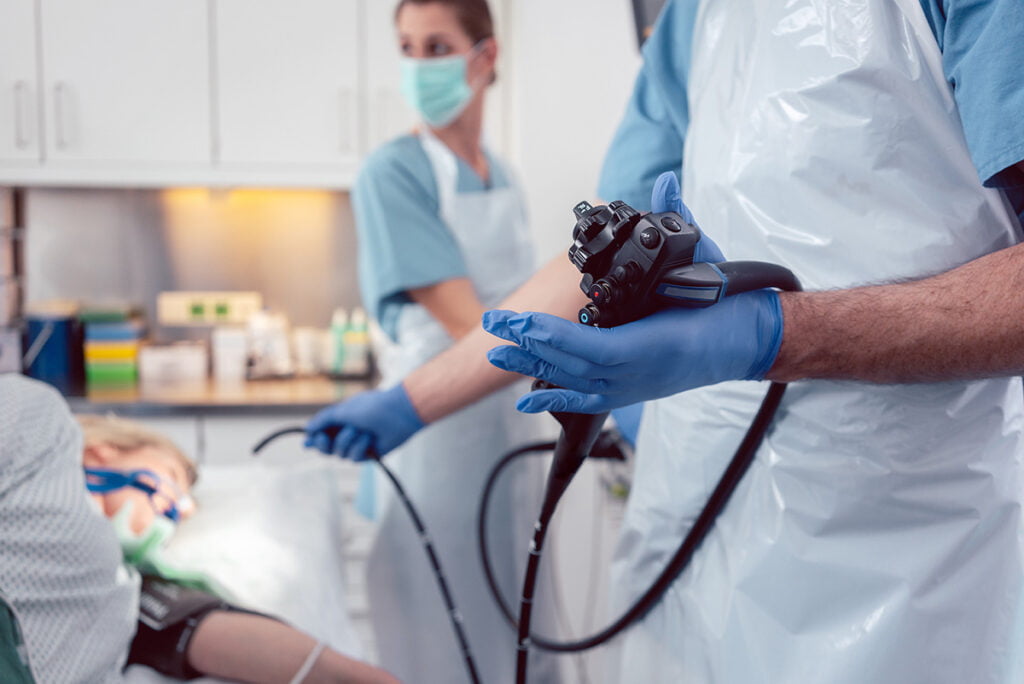“Despite the low reported rate of endoscope-related infections, multiple outbreaks are reported worldwide.” The American Journal of Gastroenterology

Endoscopy-associated infections (EAI) can occur during gastrointestinal (GI) endoscopic procedures. These infections typically manifest within 30 days and can be attributed to two primary sources: the patient’s inherent gut flora or contaminated endoscopes.
The microorganisms typically responsible for EAI include well-known ones like Escherichia coli, Klebsiella pneumoniae, Pseudomonas aeruginosa, and Salmonella enteritidis.
On a broader scale, the composite infection rate following GI endoscopy procedures is estimated at around 0.2%. However, it’s important to note that certain procedures, such as endoscopic retrograde cholangiopancreatography (ERCP), may exhibit higher infection rates.
While preventing EAI stemming from contaminated endoscopes is feasible, there exist challenges in ensuring effective infection prevention.
The FDA hasn’t yet approved single-use endoscopes, and several factors make cleaning endoscopes a complex and challenging process:
There are three ways healthcare facilities can address these challenges.
“Over 17.7 million gastrointestinal (GI) endoscopic procedures are performed annually, contributing to 68% of all endoscopic procedures in the United States.” PubMed
Each procedure requires cleaning the endoscope afterward while adhering to ST91 standards and testing cleaned endoscopes. Prompt communication about any infection outbreaks is also necessary for patient safety.
It’s essential to have clear and transparent communication regarding endoscope outbreaks or device failures. Poor communication can lead to staff stress and regulatory complications.
The FDA has emphasized that patient safety could be compromised if clinicians do not promptly and effectively report infections.
Effective communication promotes collaboration among healthcare professionals, manufacturers, and regulatory bodies. It helps them better understand and address risks related to endoscopes. Likewise, clear communication is vital in preventing infections and informing patients about potential endoscope hazards. Timely reporting and swift incident response are crucial for preventing complications and ensuring compliance with regulatory standards.
Staff morale improves when you inform them about risks and the steps you take to address them. When communications are open between medical teams, you can broaden perspectives, provide new information, and reduce persistent safety issues.
To ensure effective communication, you could:
By addressing clear communication, healthcare providers can help minimize the risk of endoscope-related outbreaks and device failures, ultimately improving patient safety and overall outcomes.
“Healthcare facilities should have a reliable, high-quality system for endoscope reprocessing which minimizes infection risks.” Center for Disease Control
Endoscopes require constant reprocessing, including proper cleaning, disinfecting, drying, and storing. The FDA recommends following reprocessing guidelines listed in the manufacturer’s instructions for use (IFU) to help prevent contamination.
The AAMI updated the ST91 standards for endoscope reprocessing in 2021. The update singled out four critical areas:
A leading cause of endoscope processing errors is inadequate training.
Personnel performing endoscope processing or sterilization need in-depth formal training. Employees should be certified and keep their certifications up to date.
Improper cleaning process timing is a critical error in many sterile processing departments.
Instruments should be cleaned within 60 minutes following a procedure.
After each use of high-risk endoscopes, there should also be a cleaning verification check. This includes bronchoscopes, duodenoscopes, linear ultrasound endoscopes, and more.
Some bacteria can remain alive in wet environments. To complete sterilization, the AAMI recommends a minimum of ten minutes of drying using instrument air or high-efficiency particulate air (HEPA)-filtered air before storage for endoscopes, all lumens, and channels. A proper endoscope drying cabinet utilizing forced air can meet this recommendation.
There should also be a check for moisture inside and outside the instrument to determine if more drying time is needed.
Healthcare facilities can store endoscopes in drying cabinets or conventional storage cabinets. However, research shows that drying cabinets reduce the risk of retained moisture and microbial contamination.
Capsa Healthcare’s TruAir™ Scope Drying Cabinet ensures patient-ready endoscopes by providing additional safety during storage and drying.
Surveillance culturing and regularly testing endoscopes also help protect patients against endoscopy-associated infections. However, testing endoscopes for microbiological surveillance culturing has limitations and differs by country. Some regions do not require testing but encourage it.
Microbiological surveillance or testing, or environmental endoscope culturing, is rapid and straightforward. It monitors the effectiveness of standard reprocessing procedures and helps find and trace contaminations in endoscopes.
Clinicians should also test scopes for defects and leaks to help prevent contamination. The CDC advises performing leak testing using the manufacturer’s IFU. Surveillance is critical for detecting damage to endoscopes’ external surfaces and internal channels.
Your scope testing should include monitoring for defects like debris, scratches, dents, adhesive disintegration, channel shredding, biofilms, or residue.
It’s crucial to regularly test and surveil endoscopes for patient safety, infection control, and regulatory requirements.
Healthcare facilities can significantly reduce the risk of endoscopy-associated infections (EAI) by focusing on three critical components: clear communication, adherence to updated ST91 standards for endoscope reprocessing, and regular scope testing and inspection. Clear and transparent communication among healthcare professionals, manufacturers, and regulatory bodies is essential for promptly identifying and addressing potential risks, promoting collaboration, and ensuring patient safety.
Adherence to the ST91 guidelines, as updated by the AAMI in 2021, is vital in maintaining the integrity of the endoscope reprocessing cycle. This includes comprehensive training, timely cleaning and verification checks, proper instrument drying, and suitable storage methods. Implementing these standards minimizes the risk of contamination and supports infection control measures.
Regular testing and surveillance of endoscopes, encompassing microbiological culturing, leak testing, and defect inspections, are indispensable for monitoring reprocessing effectiveness and detecting any issues promptly. These practices are crucial not only for patient safety but also for meeting regulatory requirements. By prioritizing these three pillars—clear communication, adherence to standards, and regular testing—healthcare facilities can enhance patient safety and ensure that endoscopes are consistently procedure-ready, contributing to improved overall outcomes and infection control.
Enhance patient safety and ensure endoscopes are procedure-ready with Capsa Healthcare’s TruAir™ Scope Drying Cabinet, an innovative solution that adds an extra layer of protection during storage and drying processes, ultimately bolstering infection control in healthcare facilities. Make the choice that prioritizes patient well-being and procedure readiness—choose TruAir™ today.